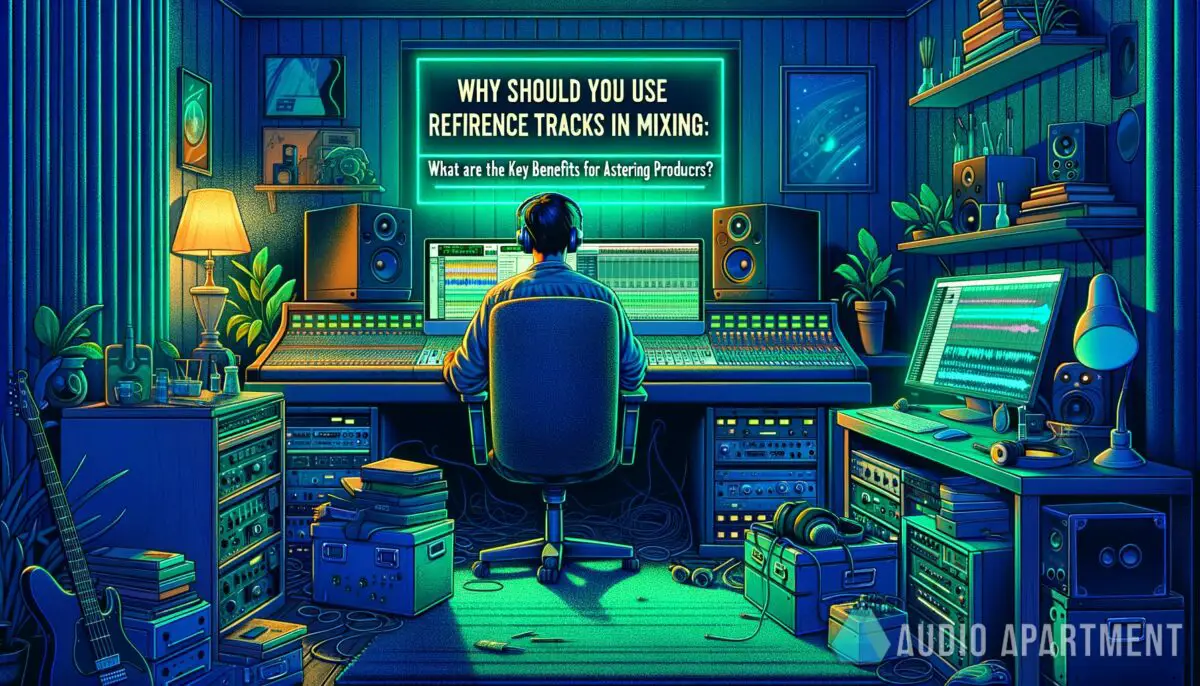Mixing down a fresh banger in your home studio can feel like you’re navigating through a maze without a map, but when you throw quality studio monitors into the mix, suddenly it’s like the north star guiding your ship. Why should you use reference tracks in mixing? It’s a heated debate lighting up forums, but the answer can be a game-changer.
You’ll learn how these sonic blueprints can elevate your mix to boss level.
Key takeaways
- Reference tracks align your mix with professional standards.
- They offer objective benchmarks for balance and sound quality.
- Mixing best practices include using reference tracks wisely.
- Pros and cons should inform your reference track usage.

How do reference tracks steer your mix right?
Imagine crafting a mix that’ll stand up to the all-time greats but realizing you’re lost in the woods of frequencies and faders. That’s where reference tracks earn their stripes, guiding you through the wilderness.

They’re the secret sauce, seasoning your mix with just the right touch of balance and space. Let’s dive into why these auditory benchmarks are non-negotiable in achieving that gold standard mix.
- Clarity in your target sound
Reference tracks provide a high-definition snapshot of what a successful mix in your genre sounds like. Using a reference is like having a sonic compass; it ensures you’re not wandering off into uncharted mix territories.
If the giants of sound swear by them, you know they pack a serious punch.
Within the labyrinth of mixing, it’s easy to lose perspective. Reference tracks act as a reality check, keeping your ears grounded.
They’re the equivalent of a seasoned mix engineer whispering tips in your ear. And just like snagging the perfect pair of studio headphones, they help you tune in to the subtleties that can make or break your track.
- Balance at its finest
A great mix is all about balance, and reference tracks are your scales. They keep you honest about levels, panning, and EQ settings.
Ever wonder why some mixes feel like a full meal and others like just an appetizer? Reference tracks.
When the elements of your mix need to jigsaw together perfectly, the reference track is the picture on the box. It guides your decisions on each piece’s fit, ensuring a coherent musical picture.
Plus, with instruments like MIDI controllers giving you infinite possibilities, a little direction goes a long way.
- Consistent quality control
Mixing with reference tracks is like having a yardstick for quality—you instantly know if you measure up. They’re the litmus test for your mix, revealing where you need to pull things up to snuff.
Quality control is paramount, especially for uploads that might get played across various platforms and devices. You want that mix to kill it in the club and on cheap earbuds, right?
Reference tracks keep you clued into how your mix translates across different listening situations, much like finding the right home studio monitors that serve up the truth, no chaser.
- Objective comparison and benchmarks
In a world as subjective as music production, reference tracks provide much-needed objectivity. They’re the yardsticks that tell you if your kick thumps like a heartbeat or if your vocals cut through like a hot knife in butter.
Comparing to reference tracks is like using GPS on a road trip. Sure, you can wing it and maybe find your way, but with a map?
You’re hitting all the stops without missing a beat. Similarly, reference tracks keep you on course when the subjective nature of music can lead to detours.
They help you avoid rookie errors that could sandbag an otherwise lit mix.
- Honing in on genre-specific techniques
Reference tracks aren’t just guides—they’re a full-on crash course in the nuances of your chosen genre. From the swagger of hip-hop bass lines to the jangling overtones of indie rock, these sonic guides highlight the must-have attributes for your mix to belong.
Think of them as the cheat codes unlocking the audio traits that fans of the genre expect and love. They keep your mix authentic and on-brand.
Mixing with reference tracks is like using GPS on a road trip. Sure, you can wing it and maybe find your way, but with a map?You’re hitting all the stops without missing a beat.
Whether it’s nailing that cavernous reverb in a dream pop anthem or that tight compression in a trap hit, reference tracks light the way. And hey, they pair beautifully with the latest drum machine evolutions and other genre-defining gear.
If you are a visual learner, check out this video titled ‘Why You Need To Use Reference Tracks When Mixing’
AKAI Professional MPK Mini MK3

AKAI Professional MPK Mini MK3
More mixing tips
Dialing in the perfect mix is like seasoning a Michelin-star dish—it’s an art form. Beyond referencing tracks, there are other techniques that can sprinkle magic on your audio canvas.
Let’s amp up your mixing skills with these more flavor enhancers.
- Experiment with automation to add life and movement to your tracks.
- Utilize parallel compression for a more dynamic sound without squashing transients.
- Shape sounds using EQ before reaching for compression; cut before you boost.
- Implement sidechain compression to let the kick drum punch through a dense mix.
- Create depth and space with reverb sends, dialing in just enough to glue the mix without muddiness.
Do’s and don’ts of using reference tracks
When you’re cleaving through the forest of mixing decisions, a few solid do’s and don’ts can save you from getting snagged on the underbrush. Here’s how to chart a path that will get you to clear skies.

| Do | Don’t |
|---|---|
| Choose reference tracks that closely match your genre. | Overwhelm your mix trying to copy the reference entirely. |
| Listen critically to identify nuances in the production. | Lose your unique sound in pursuit of a flawless reference. |
| Use high-quality files to ensure accurate comparisons. | Rely solely on one set of monitors or headphones. |
| Check your mix on different systems for consistency. | Neglect the importance of taking periodic ear breaks. |
| Reference at low volumes to assess balance and panning. | Ignore the context of your own mix elements. |
Setting yourself up for success with reference tracks is all about intention and moderation.
When comparing to reference tracks, aim for inspiration rather than imitation, ensuring your mix retains its originality.
Advantages and disadvantages of using reference tracks
Peeling back the layers of any production technique like using reference tracks, you’ll find an ambrosia of pros peppered with a handful of cons. It’s essential to consider both sides of the coin so you can strike the right balance.
Advantages
- Ensures your mix aligns with industry standards.
- Offers clear benchmarks for sonic elements like frequency balance.
- Aids in achieving competitive loudness without sacrificing dynamics.
- Accelerates the learning curve by providing real-world examples.
- Assists in maintaining focus during long mixing sessions.
Disadvantages
- May hinder creativity by tempting producers to mimic rather than innovate.
- Can lead to overanalysis and second-guessing your instincts.
- Risks intimidation or discouragement when comparing to professional mixes.
- Potentially contributes to genre homogenization, stifling unique sounds.
- Overreliance can cause ear fatigue, reducing objectivity.
In my not-so-expert opinion, using reference tracks is a no-brainer for any aspiring producer wanting to up their game. Sure, it’s vital to develop your own style, but let’s keep it 💯, getting clued in on how the pros lay it down is invaluable.
Think of reference tracks as a master class in mixing. They’re that cool cat who’s been around the block showing you the ropes, ensuring you don’t trip up as you vibe to your own groove.
If you pair this approach with the right gear, like checking out the best DAWs for producers, you’re setting yourself up for some serious studio swagger.
Yet, I’ll clap back at the notion of getting too cozy riding on the coattails of these sonic giants. You gotta remember to flip that script and infuse your mix with that personal drip – your unique artistry shouldn’t be drowned out by the shadow of a reference.
It’s a delicate dance between learning and innovating, and that’s the real tea. Soak up the knowledge, but spill your own flavor into the mix.
Frequently asked questions (FAQ)
How can reference tracks help fix issues in my mix?
Reference tracks can be an audio magnifying glass, zooming in on issues that might be muddying up your mix. By comparing elements like the kick, snare, or vocals against a polished track, you get a clearer picture of what might be lacking or overpowering.
Like checking your reflection before you step out, it helps you make sure your mix is dressed to impress.
When should I use reference tracks during the mixing process?
Crack open those reference tracks early in the mix process to set the stage and mid-mix to check your progress. It’s like having checkpoints in a race – they help make sure you’re pacing right and haven’t veered off track.
Don’t forget a final comparison once you think the mix is complete to ensure it’s ready for that victory lap.
Can I use multiple reference tracks for a single mix?
Absolutely, mixing your brew with a few reference tracks can give you a panoramic view of the sonic landscape. It’s like getting your bearings from different landmarks.
Just make sure they fit the vibe you’re going for and don’t pull you in conflicting directions. It’s all about blending flavors to create that gourmet sonic dish that’s all your own.
Final thoughts
So, there you have it, fellow audio adventurers – a mix isn’t just about slapping together tracks and hoping for the best. It’s a craft, honed by tools like reference tracks that add layers of depth, quality, and professionalism to your sound.
Embrace them as a critical ear in the room, guiding you towards that sweet spot where your mix sits just right. Hit play, lean back, and let your tracks tell their story, confident they’re tuned to perfection.
How do reference tracks influence your mixing process? Did I cover everything you wanted to know? Let me know in the comments section belowI read and reply to every comment. If you found this article helpful, share it with a friend, and check out my full blog for more tips and tricks on mixing and mastering.
Thanks for reading and keep shaping those sonic waves to perfection!















